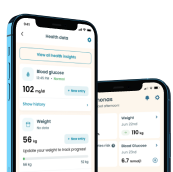Signs of Diabetes in Men: Complications & Prevention

Diabetes — one of the common conditions a good number of men experience in adulthood—can lead to different, worse complications when it develops. With this being the case, there are certain signs and symptoms that experts and health institutions advise men to look out for to know if they’re at risk of developing diabetes.
More particularly, the American Diabetes Association (ADA) and other diabetes-related health institutions have stated some of the signs that people with diabetes should look out for to know if they’re at risk.
These symptoms usually precede diabetes development, leading to further complications like atherosclerosis (clogging of the blood vessels), heart failure, and other life-threatening conditions. This article considers the diabetes symptoms that men should look out for and the risk factors of diabetes, and how to tackle them.
Signs and Symptoms of Diabetes in Men
This section examines early diabetes symptoms that generally imply the beginning stage of diabetes or that signal that it’s impending.
A common sign that men should usually look for is if their mother experienced gestational diabetes during their birth. This situation is both a symptom and a risk factor that can help men know whether they could be suffering from diabetes when other risk factors and symptoms point in that direction. That said, let’s look at other prominent diabetes signs in men.
Frequent Urination
Frequent urination has always been one of the early signs of diabetes in men. When you frequently pee such that it disrupts your sleep and leaves you feeling tired and frustrated, you possibly have excess sugar in your body, and your blood glucose is in the danger zone.
You shouldn’t overlook frequent urination as it’s a tell-tale sign that allows you to start diabetes treatment before it gets worse.
Increased Thirst
Are you drinking water more often such that it feels unnatural?
Is your blood sugar so high that it makes you worried as well?
If yes, you may be experiencing one of the early symptoms of diabetes.
Increased thirst and itchy throat are one of the major symptoms of diabetes. It’s usually complemented with frequent urination. Once you notice the condition, you should perform a test as soon as possible with a diabetes expert and get the help you need to prevent it from worsening.
Constant Hunger
Apart from being one of the major conditions of diabetes, the problem with this sign is that you may confuse it with normal hunger or an urge to just eat. So, the best way to know that it’s not unusual is if you start to notice it alongside other diabetes symptoms. That way, you’ll be able to tell if you need expert intervention or not.
Erectile Dysfunction (ED)
A man has erectile dysfunction if he can’t achieve or maintain an erection. This sexual dysfunction can also signify kidney disease, nervous system disorder, or hypertension. Other ED triggers include smoking and stress. If you experience sexual problems like ED, you should consider having a diabetes test as more than 50% of diabetic men present with the condition.
Constant Tiredness
Constant tiredness is a symptom of diabetes and a risk factor for further complications. If you’re feeling tired too often and seem to develop an intense urge to fall asleep, you should take a diabetes test or a general medical test.
The human body generally has a highly active period after eating and resting. However, when you have diabetes-influenced tiredness, you’ll barely experience this “high” period but desire to fall asleep more often.
Meeting with your doctor will help you know if you’re experiencing diabetes, enabling you to take the necessary steps to effectively implement a good disease control method.
Blurry Vision
If you notice that you have difficulty holding a steady gaze or your views aren’t as clear as they should, you should immediately test for blood glucose levels and see an expert.
Slow Healing of Cuts and Wounds
People experiencing diabetes will usually experience a slow healing process of sustained injuries. This is usually due to the imbalance of the body and weakening of the immune system such that it doesn’t actively treat cuts and wounds as it should.
If you’ve noticed that your wounds and injuries remain fresh for a long time, you may have diabetes, and running a check is extremely important.
Dark Skin Patches
Dark skin patches are one of the advanced symptoms of diabetes and present a higher risk of the condition developing into a worse complication. When patches start to appear over your body, you should treat them as an emergency by visiting a doctor for tests, diagnoses, and possible management of your condition.
Yeast Infections and Itching
Yeast infections in men are most likely caused by diabetes mellitus. This condition is one of the latter symptoms that happen and generally paves the way for diabetes. There’s increased insulin resistance at this stage, and physical sore begins to appear on the private parts.
Excess blood sugar is the major cause of yeast. Urine also acts as a food source for yeast.
When the condition starts, it’ll be visible in more moist areas than others. You’ll likely find it outside your lips, genital parts, and armpits. They’ll look like scratch wounds but are constantly itchy. These itches may be moderate to severe but are generally intolerable.
Fruity Breath
This is an advanced symptom of diabetes and spells danger for people with the condition. This stage could be followed by heart complications, kidney disease, and cardiovascular problems. Managing diabetes at this stage will require therapy, advanced treatment options, and strict adherence to the treatment process.



Complications of Diabetes in Men

Having outlined the major signs of diabetes in men, this section highlights possible complications due to failed diagnosis or merely overlooking these signs.
Nerve Damage or Neuropathy
High blood sugar can destroy or damage the nerves over time, resulting in numbness, tingling, pain, burning, or loss of feeling that starts from the tip of the fingers or toes and spreads gradually to other parts of the body. While heart nerve damage can cause irregular heart rhythm, digestive system nerve damage often results in constipation, vomiting, diarrhea, or nausea.
Retinopathy
High blood sugar from type 2 diabetes can cause retinopathy. Namely, excessive sugar in the blood can destroy the retina — the part of the eye that sends signals through the optic nerve to the brain and detects light. This occurs when the tiny blood vessels that lead to the retina get narrow, clogging over time and causing the retina to bleed or leak fluid.
Peripheral Vascular Disease
When your blood sugar levels remain excessively high for extensive periods, it could manifest as peripheral vascular disease and other serious complications. This condition occurs when the peripheral blood vessels away from the heart are damaged or blocked.
Peripheral vascular disease can also occur when there’s a high level of cholesterol and fatty substances in the blood, clogging the blood vessels.
Skin Infection
Type 2 diabetes increases your risk of having a bacterial skin infection. Bacteria can affect the skin from underneath it or in the eyelid glands. Infected skin is usually red, swollen, hot, and painful.
High blood sugar can also cause itchy dry skin, while poor blood circulation could cause your lower legs to itch uncontrollably.
Stroke
Type 2 diabetes prevents the body from adequately processing food. Namely, the body fails to use insulin properly or simply can’t make insulin, leading to sugar building up in the blood. With time, your chances of having a stroke increase as the high blood sugar destroy the body’s blood vessels.
Symptoms of a stroke include:
- having trouble talking or seeing,
- sudden confusion,
- sudden severe headache, numbness, or weakness on one side of the body.
Kidney Disease
Our kidneys pack millions of nephrons which are tiny filters. With time, high blood sugar can damage the nephrons and the kidney’s blood vessels, causing them not to function correctly. However, kidney disease could take a while to develop in diabetic people and might not show symptoms in its early stages.
Heart Disease
Diabetes increases your chance of having a heart disease (2–4 times), leading to death. You’re also more likely to have diabetes if you have a heart condition — about 35% of heart failure patients are diabetic. In other words, heart diseases and diabetes go hand-in-hand.
High blood sugar destroys the nerve and blood vessels that control the heart, leading to heart disease. However, you can reduce your risk of having heart disease with specific lifestyle changes, which we’ll discuss in the latter part of this guide.
High Blood Pressure
Many people who have type 2 diabetes usually have high blood pressure. To make matters worse, its symptoms are hardly noticeable, explaining why it’s more of a silent killer.
People who have diabetes should regularly check their blood pressure at home and share the results with their doctors. However, diabetes isn’t the only cause of high blood pressure as a diet high in fat, high cholesterol, smoking habits, genetics, and obesity can lead to high blood pressure.
Preventing Diabetes in Men

As already stated, certain signs become evident during the developing stage of diabetes. However, experiencing these signs in the beginning stage of a possible diabetes disease doesn’t necessarily imply you can do nothing to salvage the situation.
On the contrary, you can take several steps to counter and prevent diabetes. This section considers certain steps you can take if you think you’re developing diabetes or generally experiencing more than two of the symptoms mentioned in this article.
Understanding Your Genetics
Genetics is one of the major causes of diabetes in men. If you have a relative or a family history of people with diabetes, then you have an increased risk of developing the condition. While it may not show at first, you’re likely to experience blood sugar spikes more often than normal.
To know if this situation is a risk factor, you should take a genetic test and determine if you’re susceptible to the condition.
Keeping Fit
Exercising plays a major role in helping the body burn more energy. When you exercise, your body uses up excess glucose, allowing you to eliminate possible risk factors for the condition.
If you’re up to 45 years, then exercise is a mandatory preventive method to adopt so you can mitigate the effect of the condition better.
Adopting a Healthier Diet
Excessive consumption of sugary foods will increase blood sugar levels quickly and increase your vulnerability to developing diabetes. This can lead to further complications like digestive and kidney diseases, heart diseases, erectile dysfunction, and diabetic ketoacidosis.
With this being the case, you should eat only healthy foods with a low glycemic index and high fiber content (e.g., vegetables like broccoli and lettuce) as well as whole-grain foods.
Conclusion
Diabetes in men is a serious condition, just as it is for women. If left unchecked, men with prediabetes can develop diabetes and even suffer further consequences, as this article has revealed. However, the good thing is that there are steps that they can take to mitigate the risk factors and accompanying symptoms of diabetes development. Namely, with a proper understanding of the condition, genetic vulnerabilities, and day-to-day lifestyle, men can easily live a non-diabetic life and minimize their insulin dependence.
While this guide highlights many methods to prevent diabetes, one key factor is healthy food consumption. Food intake is one of the major causative factors of diabetes that people can control. Generally, the key is to avoid or drastically reduce high sugary food. However, knowing how to do that may prove difficult for some.
One way to get around this difficulty, though, is to use a digital diabetes meal planner that helps you eat the right foods. Our Klinio app is one of the best diabetic meal planners you can go for to eat healthily and live a life free from diabetes. Our app ensures that you have only enough sugar needed for energy while ensuring that your blood sugar maintains a healthy range.
Take a quiz and get your diabetes-management plan today!









